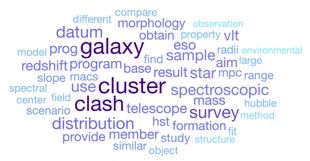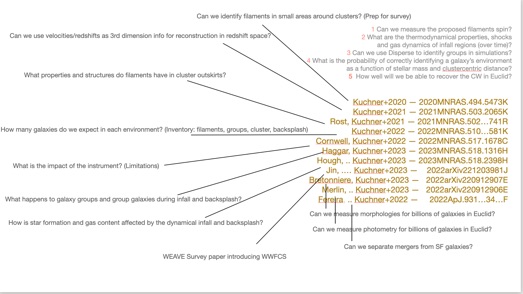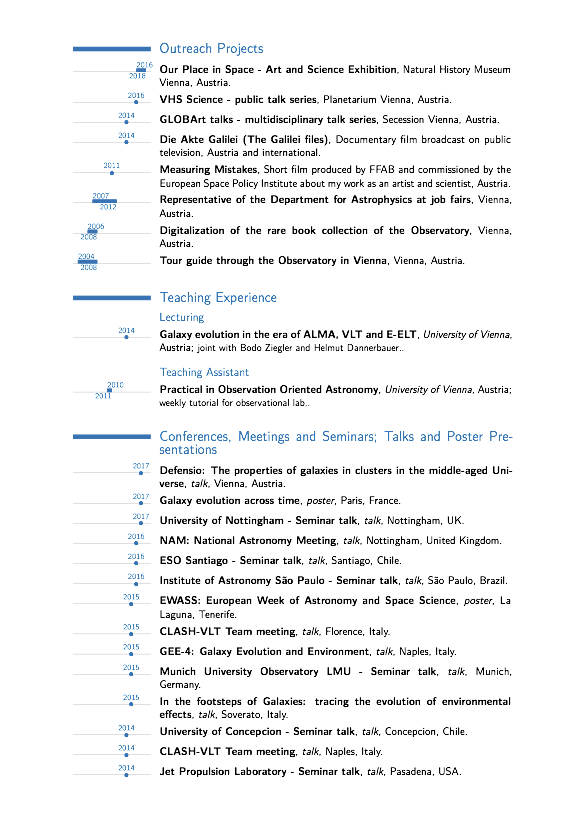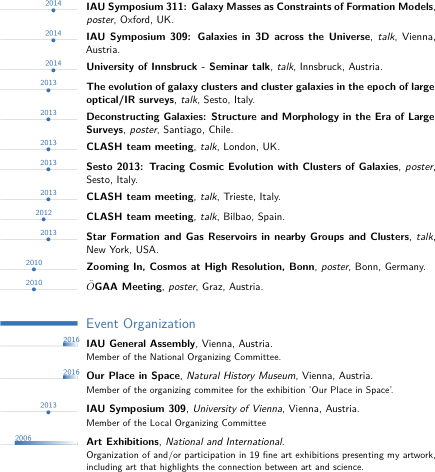36 articles in peer-review journals and 10 conference proceedings and published proposals, 3 additional papers in preparation.
RESEARCH ACHIEVEMENTS AND PEER RECOGNITION
36 published, peer-reviewed publications across astrophysics, arts and inter- and transdisciplinary research. Selected publications:
Euclid Collaboration: Bretonniere H., Kuchner U., et al, “Euclid preparation. XXVI. The Euclid Morphology Challenge: Towards structural parameters for billions of galaxies”. A&A, 2023, 671, A102, 29.
This is the second of two key pre-launch deliverables from the Euclid Morphology Working Group, serving as the reference for galaxy morphology measurements with Euclid. It culminates a five-year "Morphology Challenge" that originated from my initial studies. The lead author, a PhD student I effectively co-supervised, received a 2023 Euclid star prize for this work. In this paper, we evaluate galaxy morphology measurements using five state-of-the-art surface-brightness-fitting codes on simulated Euclid Survey galaxies. The Challenge results led to the selection of the fitting code now implemented in the Euclid pipeline.
Kuchner U., Nasser, M., Steyaert P., Maranan D., et al. “Biomodd: The integration of art into transdisciplinary research practices.” GAIA - Ecological Perspectives for Science & Society: 2023, 32/1, 144 – 153.
In this invited article, we present the SEAD collective's Biomodd project—a hybrid ArtScience creation revolving around sustainability themes ecology, humanity, technology, and technological waste. It aimed to ignite interdisciplinary experimentation and critical conversations in audiences and 100 members of the public. Our conceptual model examines how hybrid artistic practices can benefit sustainability research. We investigate the generation and evolution of ideas and the impact of online participation on the co-creation.
Haggar R., Kuchner U., Gray M., Pearce F., Knebe A., Yepes G., Cui W., “The ThreeHundred project: galaxy groups do not survive cluster infall.” MNRAS: 518, 1, 1316.
In this study led by a PhD student I co-supervised, we track the dynamics and structures of galaxy groups and their members during their orbital infall into clusters using hydrodynamical simulations of the ThreeHundred. We find that half of group galaxies become gravitationally unbound by the first pericentre, 0.5 - 1 Gyr after cluster entry. Most groups quickly mix with the cluster population and only 8 percent of infalling group galaxies leave the cluster. This suggests that groups near clusters are likely on their first infall.
Kuchner U., “Near the Origin” in A|Cerca del Origen. Fronteras Inexistentes. 2022. Natalia Rivera, Daniela Brill et al (Eds). Bogotá: Suratomica Publishing House.
This invited book chapter serves as the opening text for “A | Circa del Origen” that brings together creative and academic texts, records, and ideas of artists and scientists connected during a Suratómica residency at the CERN laboratories in 2019. The text, situated in the intersection of art theory, philosophy, and artistic research, speaks of transdisciplinary answers as origins for understandings, collaborative approaches to comprehending our (inaccessible) cosmic origins and translation of artistic intention into tangible impact.
Kuchner U., Haggar, R., Aragón-Salamanca A., et al., “An inventory of galaxies in cosmic filaments feeding galaxy clusters: galaxy groups, backsplash galaxies, and pristine galaxies”. MNRAS, 2022, 510, 581.
This article defines the benchmark for overcoming the notorious challenge of disentangling various pre-processing modes in cluster infall regions. Cluster filaments encompass heterogeneous environments, from embedded galaxy groups to backsplash galaxies that contain a record of their passage through the cluster. Robust identification of components is crucial for breakthroughs with imminent surveys. I use cosmological simulations to track haloes, identify their environment and dissect the population of filament galaxies.
Kuchner U."The Value of ArtScience: improving the balance in collaboration practices between artists and scientists can impact knowledge production.” Writing Visual Culture, 2021, Vol 10, ISSN: 2049-7180
This article gives a conceptual analysis of ArtScience collaborations, explores reasons for the common disparity between anticipation and outcome, and offers solutions. Combining insights from the academic debate into inter- and transdisciplinarity and my experience, I found that a guided integration of the disciplines and a dedicated space is vital for bias detection and to gain the necessary familiarity of the other discipline.
Kuchner U., Aragón-Salamanca A., Rost A., Pearce F. et al., “Cosmic filaments in galaxy cluster outskirts: quantifying finding filaments in redshift space”. MNRAS, 2021, 503, 2065.
In practice, finding filaments is complicated by redshift space distortions (RSD) related to the peculiar velocities of galaxies. This is widely expected to be most challenging in cluster infall regions and had not been addressed specifically in the literature. In this article I tested methods from large-scale-structure studies in the dynamically complex cluster infall regions. This led to me designing the first fully tested RSD mitigation strategy for filaments in cluster infall regions, ready for application to WEAVE and 4MOST survey data.
Rost A., Kuchner U., Welker, C., et al “The ThreeHundred: the structure and properties of cosmic filaments in the outskirts of galaxy clusters”. MNRAS, 2021, 502, 714
This is a companion article to Kuchner et al. 2021, led by a PhD who I supervised for this project. We show the turbulent gas flow collapsing onto filaments around galaxy clusters, and the shocks where filaments penetrate the cores of clusters. This underlines the important role of gas physics in galaxy, filament and cluster evolution. Together these articles are fundamental to robust detection and interpretation of cluster filaments.
Kuchner U., Aragón-Salamanca A., et al. “Mapping and characterisation of cosmic filaments in galaxy cluster outskirts: strategies and forecasts for observations from simulations”. MNRAS, 2020, 494, 5473
This article defines how to identify cosmic web filaments with a new generation of spectroscopic surveys. This is a challenge because of the filaments’ low contrast against their surroundings. A strength of this work is the combination of state-of-the-art hydrodynamic simulations and observations. Our results provide a reference for numerous upcoming studies of wide-field spectroscopic surveys and will shape their design.




